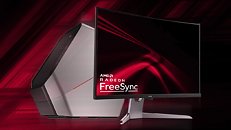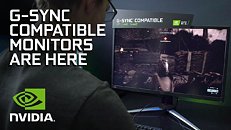Monday, November 25th 2019

NVIDIA to Open G-Sync Monitors to VRR Support, Enabling AMD Graphics Cards Support
In the wars of variable refresh rates, much ink has already been spilled regarding the open, AMD FreeSync approach and NVIDIA's proprietary G-Sync modules. The war started to give its first signs of abatement once NVIDIA seemed to throw in the towel by officially supporting VESA's VRR (Variable Refresh Rate) technology on its graphics cards, basically opening the way for NVIDIA graphics cards to correctly operate with previously AMD FreeSync-branded monitors. Now, it seems one more step will be taken on that road which should be G-Sync's proprietary approach final whiff, since according to a report from TFT Central, confirmed by NVIDIA, the company will enable VRR support for next releases of monitors equipped with the company's G-Sync module. This will essentially enable AMD graphics cards to work with NVIDIA-branded G-Sync monitors.This move will only work for future monitor releases, mind you - a firmware update which will be distributed amongst monitor makers will enable the next releases of G-Sync to support VESA's VRR standard. This will not, apparently, be happening with already-released G-Sync modules, whether carrying NVIDIA's first take on the technology, nor the v2 G-Sync modules. It's not a perfect solution, and current adapters of G-Sync are still locked-in to NVIDIA graphics cards for VRR support on their monitors. It is, however, a definite step forward. Or a step backwards from a proprietary, apparently unneeded technology - you can really look at it either way.Whether or not this makes sense from a product standpoint will only be understood once pricing on future NVIDIA G-Sync monitors surfaces - but we are finding it a hard sell for monitor makers to invest much in the G-Sync module going forward, since there are no practical, user-observable differences aside final product cost.
Source:
TFT Central



66 Comments on NVIDIA to Open G-Sync Monitors to VRR Support, Enabling AMD Graphics Cards Support
Could be there are other benefits, but I absolutely don't miss Gsync. I can actually enable Gsync now with latest drivers, but I see no benefits, in fact enabling FreeSync on my Samsung messes with/lowers the brightness for some damn reason, so there's just no reason for me to enable it to use it in Gsync-compatible mode.
Also. Shouldn't the news read, Nvidia admits defeat in VRR arena, paving the way for open and easy to implement standards, the way it was meant to be played.
Tearing happens when the video output is not in sync with the refresh rate, no matter how you limit the frame rate, unless some form of synchronization exists, you'll always get tearing.
Guess it wasn't true afterall... good thing I never bought or recommended any display crippled with a Gunkified display controller.
Anyway it is weird that NV is going free on this stuff. Wonder what makes NV do that. It's not the fear of the Gsync modules or monitors equipped with these modules not being sold well enough for sure. There must be some other reasons here.Oh, of course it wasn't. Grow up :D
But as an implementer and promoter of said techs, yes, AMD did most of the heavy lifting.
And imagine all the wonderful possibilities of crippling competitor's GPU that one has in that scenario.
Amazing how some people always have to find something to complain about.
Rather than this (now completely unnecessary) G-Sync/Freesync branding - monitor manufacturers should just list the refresh rate like this:
60Hz
48-60Hz
40-75Hz
120Hz
30-144Hz
etc....
It's not rocket-science to work out which ones have variable refresh rates and which ones don't and there's zero ambiguity. At the moment you have "144Hz monitors" that may or may not support VRR, the existence of which is often buried deep in the detailed specifactions and an afterthought, and you're lucky if the refresh rate range of VRR is even mentioned.
Whether that's worth the cost of G-Sync is debatable, but I have listed a couple of reasons why G-Syns still exists.
I'm looking at a slim/portable 14" laptop and I'm noticing one with a 3700U and 48-60Hz VRR panel. Being able to run a game at 48Hz instead of 60Hz is equivalent to a 25% performance boost when seen in the context of avoiding stuttering, which is the number one concern for me when low-end gaming. Hell, it might even be the sort of jump that allows running at native 1080p instead of non-native 720p. That sort of difference is HUGE.